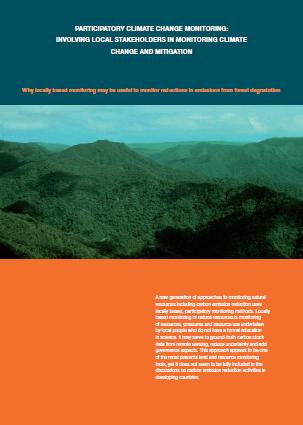

Research initiatives
Climate Change
Monitoring in Developing Countries
Monitoring Matters: Comparative Analysis of Innovative Approaches
Locally based Monitoring and Indigenous People in the Arctic
The 2004 Symposium
‘Monitoring Matters’
Climate Change Monitoring in Developing Countries
Deforestation continues at an alarming
rate. It results in release of greenhouse gases originally stored in the
trees and in other organic matter.
Reducing and preventing deforestation is the mitigation option with the
largest and most
immediate carbon stock impact in the short term per hectare and per year
globally Most forest-clearing and forest degradation occurs in developing countries.
The post-Kyoto international climate regime will mandate forest
conservation payments. Greenhouse gas emission reduction from forest
conservation has much lower cost than reducing emissions from
fossil fuels. Carbon traders and donor agencies demand accountability,
transparency and quantifiable achievements in return for their support. In
order to ensure the support of the people living in the forested areas,
transparency, participatory decision-making and benefit sharing are necessary. No common methodology is in place to estimate and verify carbon
emission reduction benefits in initiatives to reduce forest degradation and
improve land and resource management.
Locally based monitoring may serve to ground-truth data from remote sensing,
reduce uncertainty and add governance aspects yet it does not seem to be
fully included in the development of carbon emission reduction activities in
developing countries. Details on why locally based monitoring may be useful
to
monitor reductions in emissions from forest degradation are available.
Download the leaflet:
| English | |
| Spanish | |
| French | |
Three factors make locally based monitoring techniques particularly
relevant:
- They can promote accountability of carbon emission reduction efforts.
- They appear effective in incorporating evidence-based assessments in decision-making at the local level, and thus have considerable potential to influence on-the-ground management activities in favour of sustainable forest management.
- They can generate ownership to carbon
emission reduction efforts, and they can encourage equitable
benefit-sharing at local levels and contribute to build social capital.
Impacts of Reducing Emissions from Deforestation and Forest Degradation and Enhancing Carbon Stocks
A research project, ‘Impacts of Reducing Emissions from Deforestation and Forest Degradation and Enhancing Carbon Stocks’, abbreviated I-REDD+ (LINK: www.i-redd.eu), was initiated in 2011. This project is exploring effective approaches to monitoring of REDD+ initiatives. It is facilitating parallel community-based and scientist-executed monitoring of forest biomass and biodiversity in forested landscapes in Vietnam, Laos, China and Indonesia. The I-REDD+ project is funded by the 7th Framework Programme of the European Commission.
‘Monitoring Matters: Comparative Analysis of Innovative Approaches’
A four-year research programme, ‘Monitoring
Matters: Comparative Analysis of Innovative Approaches’, abbreviated MOMA,
was initiated in 2006.
The MOMA
programme examined whether the locally-based monitoring approaches can
detect true local or larger-scale natural resource trends and address the
shortfalls of conventional monitoring.
This programme conducted quantitative comparisons of the findings of
locally-based vis-à-vis conventional natural resource monitoring in selected
sites in five priority developing countries. These countries were Ghana,
Madagascar, Nicaragua, the Philippines and Tanzania.
The programme was funded by the Research Council of the Danish Government
(Danida). Key scientific articles from this programme are available at this
website, under publications.
Locally-based Monitoring and Indigenous People in the Arctic
Locally-based approaches to monitoring of
natural resources appear to be relevant in the Arctic
(see Science 2007). In Greenland, the livelihood of the 2,500-3,000
full-time hunters and fishermen is threatened by
climate changes. With
the rapid change in ice and snow cover, the future of the hunting and fishing
communities remains uncertain. Moreover, Greenland is being widely
criticised internationally for the decline in the numbers of several
species. Recently, the Home Rule Government has issued new policies for
hunting but the regulations are not benefiting from support of the local
people.
In 2008, the Home Rule
Government organized a 4-day seminar on "Sustainable Management of
Living Resources" for hunters and fishermen and the local government
administration. One of the topics discussed was the possible potential of
locally based monitoring to further improve the dialogue between local
stakeholders, government resource managers and scientists, and to enhance
the capacity of local community members in resource monitoring and
management.
With funds from the Nordic
Ministerial Council and the
Government of Greenland,
we are establishing and testing locally-based monitoring of resources in
four communities in Disko Bay and Uummannaq,
Qaasuitsup Municipality
in North West Greenland. We expect the activities to improve the capacity
and opportunities of the communities in terms of monitoring and managing
resources within sustainable limits. Moreover, we expect it to improve
communication and understanding between users and natural resource managers
at a higher level. Experiences from this pilot project will be analysed and
disseminated amongst Arctic decision-makers, scientists and managers. The
initiative benefits from valuable lessons from involving local hunters in
monitoring the populations of eider and caribou. The project is contributing
to the implementation of the Arctic Council’s strategy on community-based
resource monitoring (CAFF/2008).
This strategy is available here.
Follow the
project website at www.pisuna.org
Read the leaflet on locally-based monitoring in the Arctic:
English version Russian version
The 2004 Symposium ‘Monitoring Matters’
The suggested benefits of locally-based monitoring of natural resources are promising. An important question however is: How much of the potential of locally-based monitoring can be translated into tangible results on the ground? To address this question, the Nordic Agency for Development and Ecology (NORDECO, Denmark), and the Zoology Department of Cambridge University (UK) hosted a two-day symposium on locally-based monitoring in Denmark in 2004.
Fifteen case studies were presented and discussed at the symposium (See objectives; and Programme) The case studies have all been published in a Special Issue of Biodiversity and Conservation.
